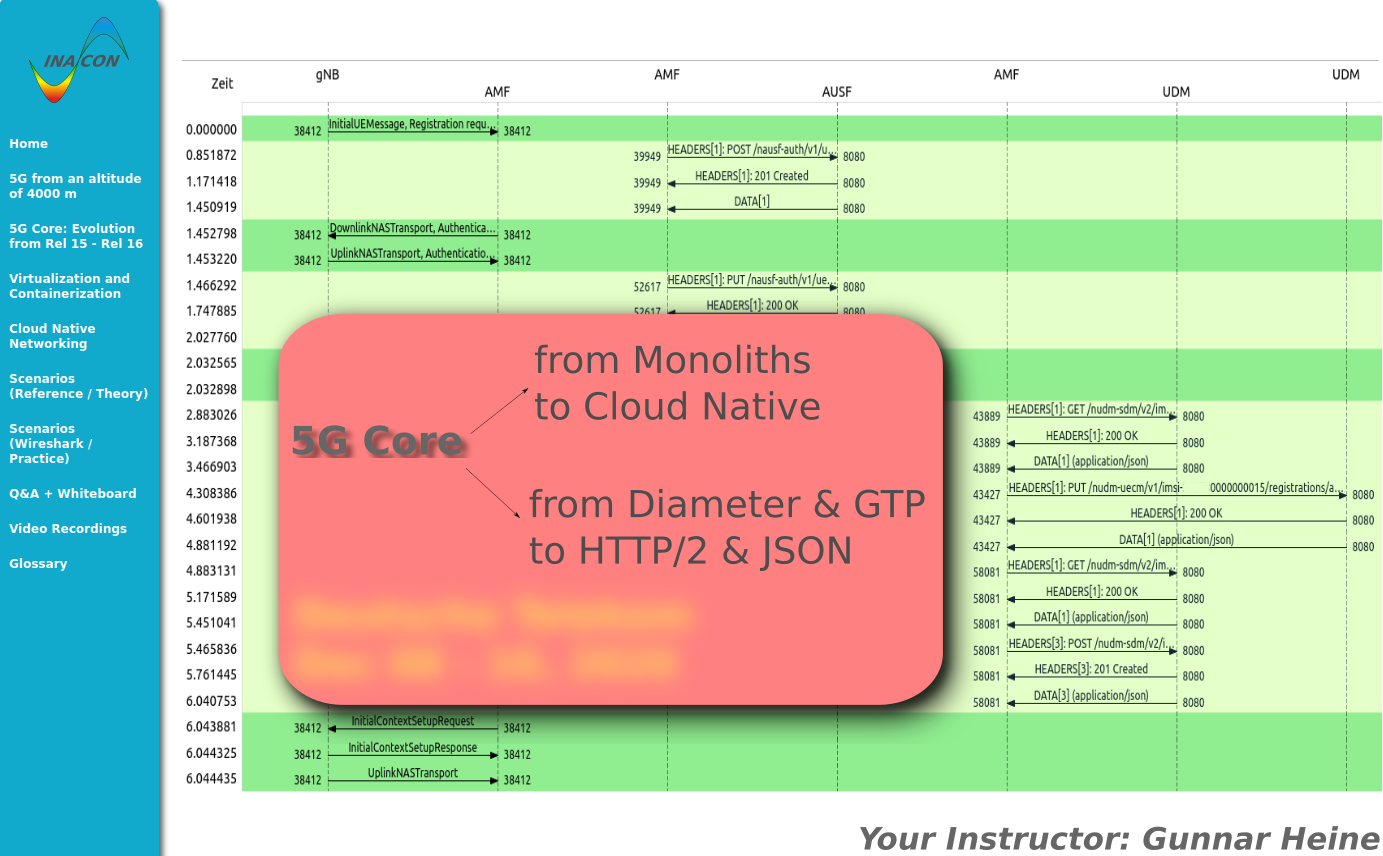 5G Core: From Monoliths to Cloud Native / From Diameter & GTP to HTTP2 & JSON
5G Core: From Monoliths to Cloud Native / From Diameter & GTP to HTTP2 & JSON
[alternatively 3 full days OR 5 x 1/2 day course, Euro 3,450.- (net) per participant]

Training Course Description
- This course addresses the needs of technical engineering staff who require a detailed understanding of the 5G core network, built inside Kubernetes (K8s) cluster using containers and cloud-native networking to host micro-services.
- This course has been designed to meet the requirements of both: engineering experts to design and test such micro-services inside K8s and operations staff to operate and maintain a container-based 5G core network.
- The course starts out with a wrap-up of general 5G-topics like a short overview of NSA vs SA, the future of RAN and QoS in 5G.
- The whole next chapter is dedicated to the detailed definition of the various new network functions inside the 5G core, e.g. AMF, SMF, UPF, NRF, SEPP, to name a few.
- In that respect, it is our target to make the students understand how these network functions are physically realized as micro-services inside a cloud-based environment.
- Of course, we also explain in detail the HTTP/2- and JSON-based communication among these network functions in a service based architecture (SBA).
- In the following chapter we highlight the differences between HW-virtualization and VM’s on one hand and OS-virtualization and containers on the other hand.
- Focus in this chapter is on hands-on and life creation and setup of images and containers and their use for different purposes (e.g. Apache web server).
- Chapter 4 is dedicated to container orchestration through Kubernetes and the various specifics of Kubernetes.
- That relates in particular to the thorough analysis of the Kubernetes cluster architecture, namely the worker node(s), pods and the master node.
- Another focus is on the operation of micro-services inside a Kubernetes cluster, namely load balancing, IP-addressing and networking among pods and containers.
- Much effort is again spent on practical exercises with real-life use of a running Kubernetes cluster in our network.
- The following two chapters 5 and 6 are dedicated to the new 5G signaling procedures with focus on core network.
- Most important: These two chapters are complementing each other with chapter 5 depicting the theory part according to the standard and chapter 6 providing the peer hands-on logfiles.
- This provides students with real-life exposure to the meaning of parameters and messages in 5G.
- Chapter 6 is also referred to frequently earlier in the course to emphasize the interaction among micro-services in the 5GC.
Some of your questions that will be answered
- How are network elements and network functions broken down into micro-services?
- Why does the 5GC require the use of HTTP/2 and JSON for the communication among the micro-services / network functions?
- What is HTTP/3 and does it currently play any role in the context of 5G?
- What is the meaning of PRINS and OAUTH2.0 and how does it enable secure communication among 5G core networks in case of roaming?
- Which network function in the 5GC is responsible for which tasks?
- How is the 5GC physically realized in a Kubernetes environment?
- Which constraints apply for the size of Kubernetes cluster in terms of No of pods, nodes etc.?
- Why does 3GPP endorse new authentication options like EAP-TLS?
- How does a UE register to the 5GC and which network functions are involved?
- How does a UE obtain its IP-address(es) from the network and which network functions are involved?
- How does Inter-RAT mobility work between LTE and NR, esp. with N26-interface deployed?
- What are the differences and specifics of HW- and OS-virtualization? What are the differences and specifics of containers and virtual machines?
- How precisely does mobile edge computing work and which requirements does it impose on the 5GC?
- What happens if the UE needs to register to a specific network slice?
- Why does 3GPP introduce the 5G-AKA authentication procedure and what are differences compared to EPS-AKA?
- How can we trace the signaling among different containers in a cloud?
- How does Kubernetes achieve load balancing among different pods?
 Pre-Requisites
Pre-Requisites
- The students need to have basic understanding of 5G but good understanding of the EPC.
- Practical experience with LINUX CLI is beneficial as we perform quite a few life exercises.
 Training Course Target
Training Course Target
- The students will gain thorough understanding of the 5GC network functions and how they are realized as micro-services.
- Through our deep dive into container and Kubernetes practice the students can put their hands in the mud and gain practical experience with cloud-native operation.
- Finally, the students will understand the signaling flows when UE, NR-RAN and 5GC interact with each other in various different scenarios.
 Training Course Duration
Training Course Duration
- alternatively 3 full days OR 5 x 1/2 day course
v1.000
ℹ️ Try out the updated search below!
Search:
More Info:
Detailed ToC of this training course
INACON eBooks
Please have a look at our full offer

